

 Varietal or terroir? Or just “different”?
Varietal or terroir? Or just “different”?
The grape variety was not really important before the New World wines appeared on a larger scale in the 1990s.
Well, of course it was important. But consumers did not care about which grapes the wines were made of. They bought a Bordeaux, a Burgundy, a Moselle or Rhine wine, a port wine, a champagne. They bought a wine style or an origin. Not a grape. Then the New World wines appeared and, all of a sudden, Chardonnay and Cabernet Sauvignon took the centre stage.
Wine enthusiasts today are often obsessed with the grape variety. Yes, it is interesting to know the varieties in the wine. As long as you don’t always expect the producer to tell you the exact percentages. Maybe he doesn’t remember or maybe he doesn’t feel it is that important to be too precise. And sometimes you have to realize that it is not the grape character you feel in the wine, but rather where it comes from and in what style it is made.
You can (fairly) often recognize a Bordeaux but it is really not easy to say if it is Merlot or Cabernet Sauvignon based. You can recognize the warm tones of a Languedoc but guessing the grape mix is a challenge. A sauvignon blanc from Sancerre or New Zealand is completely different from a white Bordeaux, even when it is made from 100% sauvignon.
Today grape varieties cross the borders like never before. To some extent, this is because of the climate change. Bordeaux, for example, experiments with Syrah and Grenache. Perhaps a producer is looking for freshness in Languedoc and decides to plant Sauvignon Blanc.
But another reason is that today many consumers want something different, something unexpected. Portuguese grapes are successful in California. A Bordeaux with 100% Carmenère? With the right label and right sales channels, it should be a blockbuster. (In fact, there already is such a wine on the market!)
Don’t forget to take a look at our wine tours and book one that you think looks exciting.
Britt & Per
PS: Recommend to your friends to read the Brief!
– – – – –
What’s on at BKWine Tours
Autumn 2018
- Champagne, September 26-30
- Bordeaux, October 10-14
- Douro Valley in Portugal, October 17-21
- South Africa, November 9-19
Winter 2019
- Chile-Argentina, January 20 – February 4, 2019
- South Africa, February 16-24, 2019
- New Zealand, March 11-26, 2019
For more information please contact us on email or on phone (we’re on French time), or go to our wine travel site on www.bkwinetours.com!
We also make custom designed wine tours – on-demand tours for you and a group of friends, for your company (maybe to scout new winegrowers?), for a special event… We can combine winery visits and wine touring with other activities: gastronomic workshops, visit to an oyster farm, truffles hunting, cheese making, and more. More info on the custom designed and bespoke BKWine wine tours and travel here!
Read our book(s)
We have written several wine books, nine at the last count. One of them has been translated to English; the others are (so far) only available in Swedish. This is the one that is available in English: Biodynamic, Organic and Natural Winemaking, Sustainable Viticulture and Viniculture
All our books are on wine, but on different subjects: wines of the Languedoc, wine growing and wine making, the wines of France, Tuscany, Bordeaux, Piedmont, Burgundy, Champagne. Several have won prestigious prizes and awards. Read more on our wine books.
From the World of Wine
In Brief
In short, news and stuff from the world of wine.
Shelf life for bag-in-box wines
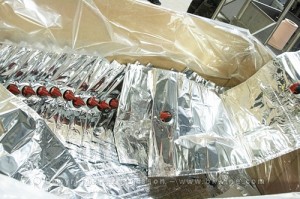 Bag-in-box wines have shorter durability than wines in bottle. And the small sizes, 1.5 and 3 litres have the shortest. These sizes are now becoming more and more popular, also in France. At a recent bag-in-box conference, where Smurfit Kappa and other bag-in-box manufacturers participated, it was discussed whether it is possible to improve, at a reasonable cost, the longevity of this kind of packaging. It was clear that the most important thing is to protect the wine from oxygen, especially when filling the bags.
Bag-in-box wines have shorter durability than wines in bottle. And the small sizes, 1.5 and 3 litres have the shortest. These sizes are now becoming more and more popular, also in France. At a recent bag-in-box conference, where Smurfit Kappa and other bag-in-box manufacturers participated, it was discussed whether it is possible to improve, at a reasonable cost, the longevity of this kind of packaging. It was clear that the most important thing is to protect the wine from oxygen, especially when filling the bags.
For a good result, you should make a proper filtering of the wine, add a sufficient amount of sulphur, top up the bag with nitrogen and ensure that the bag-in-boxes are kept cool during transportation. And then it is up to the wine merchants and the importers to sell the wines quickly. Smurfit Kappa recommends that a red BiB is drunk within 10 months and a white within 8 months. Read more vitisphere.com
World wine production and consumption 2017, some statistics
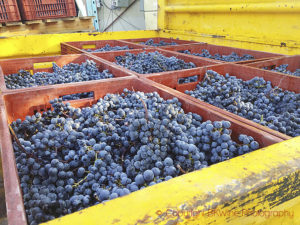 OIV, the International Organization for Wine and Vine, recently presented the figures for the wine production in the world in 2017. The world has now 7.6 million hectares of vines; this figure includes table grapes and raisins. The production of wine in 2017 was 250 million hectolitres. This volume is historically low due to the difficult weather conditions in Europe. The consumption of wine in the world was 243 million hectolitres. So the world drinks more or less the same volume as it produces. Consumption has stabilized since the economic crisis in 2008. Even a slight increase has been noticeable since three years back.
OIV, the International Organization for Wine and Vine, recently presented the figures for the wine production in the world in 2017. The world has now 7.6 million hectares of vines; this figure includes table grapes and raisins. The production of wine in 2017 was 250 million hectolitres. This volume is historically low due to the difficult weather conditions in Europe. The consumption of wine in the world was 243 million hectolitres. So the world drinks more or less the same volume as it produces. Consumption has stabilized since the economic crisis in 2008. Even a slight increase has been noticeable since three years back.
If we look at the consumption in individual countries, the US is at the top with 32.6 million hectolitres of wine. France is second with 27 million, Italy in third place with 22.6, Germany fourth with 20.2 and China fifth with 17.9 million hectolitres. And the world continues to love sparkling wines. Exports have increased by 11.2% in volume and by 8.9% in value since 2016. Read more: oiv.int.
Export wine, yes, but at what price?
Wine is found in all possible price ranges. One is as often amazed at how inexpensive wines can be as at how expensive wines can be. At what prices do different wine countries sell their wines in the export market? We recently saw some interesting statistics for 2017 that compare export prices for the most important wine countries.
The French wines are among the most expensive in the world. Not a big surprise. On average, the French still wines are exported for USD 5.69 per litre. But France is not the priciest wine country. The American wines are exported for USD 6.79 per litre and the New Zealand wines for 5.86 $/lit. Italy exports its still wines for 3.84 $/lit and Spain for 2.30 $/lit. These numbers are for wines that are exported in bottle.
For the bulk wines the prices are totally different. Here, Spain is in the lead in terms of volume and the export price is no more than 0.47 USD per litre. Read more about this interesting export statistics here mon-viti.com
New travel destination: New Zealand
We have just launched a new and really exciting travel destination: New Zealand. The country is best known for its white wines made from sauvignon blanc (and perhaps also its rugby team?), but there are many other excellent wines as well, for instance exquisite pinot noir and powerful syrah wines. It is also a country with a legendarily beautiful scenery with many exciting things to see and to visit. Naturally, this is a long tour so we will mix wine visits with nature experiences, excursions, culture and of course gastronomy. The program for the wine tour to New Zealand has just been published on the BKWine travel site.
What you need to know when visiting Santa Cruz in Chile’s wine country
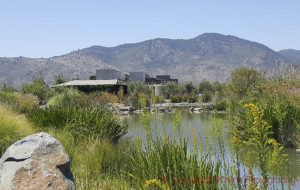 Chile is a very exciting wine country today, really worth visiting. When you come to Chile you will surely also come to Santa Cruz. Santa Cruz is a small town in the Colchagua Valley in Chile. It has around 40 000 inhabitants. It is the almost inevitable base-camp to explore the famous Colchagua Valley, and, for example, Lolol, Apalta, Cachapoal, Rapel, Curico, and other nearby valleys and regions. It is about 2 hours south of Santiago, in the Chilean region curiously named “General O’Higgins”.
Chile is a very exciting wine country today, really worth visiting. When you come to Chile you will surely also come to Santa Cruz. Santa Cruz is a small town in the Colchagua Valley in Chile. It has around 40 000 inhabitants. It is the almost inevitable base-camp to explore the famous Colchagua Valley, and, for example, Lolol, Apalta, Cachapoal, Rapel, Curico, and other nearby valleys and regions. It is about 2 hours south of Santiago, in the Chilean region curiously named “General O’Higgins”.
We have just published a “city” guide (it is a small city) with our selection of where to eat and what to do on BKWine’s Travel Blog: Santa Cruz in Colchagua, Chile, a short “city” guide.
If you really want to discover the fantastic wines and the wine countries of South America you can come on a wine tour to Chile-Argentina with BKWine.
You can find more wine city guides – to Beaune, Bordeaux, Saint Emilion, Mendoza, Buenos Aires – on the travel site.
We also have a few short introductions to wine regions as well as good things to know, “country FAQs”, on restaurants, food, transport, tipping and more, in some wine countries.
“Organic” sulphur to be launched next year
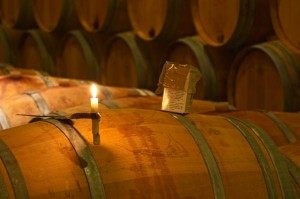 Sulphur is something that is naturally present in our environment and it is a product that is allowed for all wine producers – organic as well as conventional – both to combat fungal diseases in the vineyard and as an antioxidant in the finished wine. However, there is a certain demand from organic producers for an “organic” sulphur product. Most of the sulphur used today is a by-product of oil refining. The company De Sangosse will next year launch a new product based on sulphur that can be used against the fungal disease oidium. The special thing about this product is that the sulphur comes from recycling of agricultural products. Residues from agriculture are used to produce biogas and the sulphur formed in the process is refined and used for this new product. Read more about this new product vitisphere.com
Sulphur is something that is naturally present in our environment and it is a product that is allowed for all wine producers – organic as well as conventional – both to combat fungal diseases in the vineyard and as an antioxidant in the finished wine. However, there is a certain demand from organic producers for an “organic” sulphur product. Most of the sulphur used today is a by-product of oil refining. The company De Sangosse will next year launch a new product based on sulphur that can be used against the fungal disease oidium. The special thing about this product is that the sulphur comes from recycling of agricultural products. Residues from agriculture are used to produce biogas and the sulphur formed in the process is refined and used for this new product. Read more about this new product vitisphere.com
Sexual confusion in the vineyard, in a new simpler version
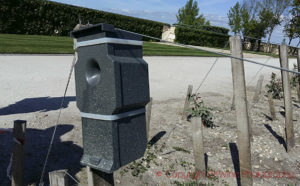 When we visited Château Pichon-Baron, grand cru classé in Pauillac, last week we saw a small canister in the vineyard that we have never seen before. This canister is called CheckMate Puffer and is a new way of distribute pheromones that protect against the grape worm with the method with the curious name “sexual confusion”. The grape worm is the larva of two types of moth, cochylis and eudemis, and can cause serious damage in the vineyard.
When we visited Château Pichon-Baron, grand cru classé in Pauillac, last week we saw a small canister in the vineyard that we have never seen before. This canister is called CheckMate Puffer and is a new way of distribute pheromones that protect against the grape worm with the method with the curious name “sexual confusion”. The grape worm is the larva of two types of moth, cochylis and eudemis, and can cause serious damage in the vineyard.
When you use sexual confusion the most common method is to place small brown capsules in the vineyard, about 500 per hectare. It is a time-consuming operation. One big advantage with the Checkmate Puffer is that you only need a maximum of 4 canisters per hectare. The canister does not spray pheromones continuously. In the canister there is a timer and the spraying takes place in the evening and at night when the moths are out flying. As with the more common small capsules, you need to use it on at least 5 hectares of contiguous vineyards for the Puffer to be effective.
Screwcaps increase in popularity to reach 30% market share according to a study
More and more wine bottles are sealed with screwcap, according to a survey. The screwcap has increased its market share in the world by 13.2% from 2012. Today it has 29.6% of the world market. In total, 30 billion bottles are sold annually in the world, of which 9 billion are closed with a screwcap.
In the United States, the screwcap now has 45% of the market. Also in countries such as Germany, Britain and France, it is becoming more and more popular. However, don’t write off the natural cork just yet. Read more: meininger.de
Features
Features that we have published during the past month, with lots of reading for you.
Tuscany presents its recent vintages, Chianti Classico 2015 and 2016
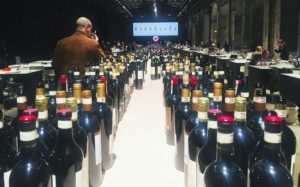 Each year, Tuscany presents the recent vintages in a gigantic tasting, the so-called “anteprima”. BKWine’s reporter Åsa Johansson was there: “I concentrated on Chianti Classico 2016, where many producers chose to have barrel samples of wines not yet bottled, and Chianti Classico 2015. After two days of tasting and spitting sitting at a table, while fifty super-fast sommeliers ran back and forth with the bottles, I can only confirm how far Chianti Classico has come.”
Each year, Tuscany presents the recent vintages in a gigantic tasting, the so-called “anteprima”. BKWine’s reporter Åsa Johansson was there: “I concentrated on Chianti Classico 2016, where many producers chose to have barrel samples of wines not yet bottled, and Chianti Classico 2015. After two days of tasting and spitting sitting at a table, while fifty super-fast sommeliers ran back and forth with the bottles, I can only confirm how far Chianti Classico has come.”
Read more in Åsa Johansson’s article on BKWine Magazine: Anteprima in Tuscany: Chianti Classico Collection 2018.
Noble wines in new vintages: Vino Nobile di Montepulciano 2015 and 2013
 During the week of Tuscan previews, anteprime, invited journalists travel from one town to the next starting in Florence, to taste new vintages of the region’s wines. When it was time for Vino Nobile di Montepulciano, hopes were high, but how did it actually go? BKWine Magazine’s Åsa Johansson reports from the tasting.
During the week of Tuscan previews, anteprime, invited journalists travel from one town to the next starting in Florence, to taste new vintages of the region’s wines. When it was time for Vino Nobile di Montepulciano, hopes were high, but how did it actually go? BKWine Magazine’s Åsa Johansson reports from the tasting.
Read Åsa Johansson’s full article on BKWine Magazine: Vino Nobile anteprima: New vintages of Vino Nobile di Montepulciano.
A new winery opens in … Gothenburg on the Swedish rainy west coast, Wine Mechanics
 “A winery in Gothenburg sounds like an April Fool’s joke, but it is not. Nor is it a result of that the feared climate change has made farming conditions favourable in our dear Rainy City, which would be almost as scary as prevailing world politics. This is something completely different. Wine made in Gothenburg, but from grapes of the noblest varieties transported here from well-known areas in France and Germany.”
“A winery in Gothenburg sounds like an April Fool’s joke, but it is not. Nor is it a result of that the feared climate change has made farming conditions favourable in our dear Rainy City, which would be almost as scary as prevailing world politics. This is something completely different. Wine made in Gothenburg, but from grapes of the noblest varieties transported here from well-known areas in France and Germany.”
Read Mattias Schyberg’s full article on BKWine Magazine: Wine Mechanics, Gothenburg’s first urban winery opens on April 18!
2013 in Brunello di Montalcino shows its strengths
The week of Tuscan previews, anteprima, ended with the presentation of Brunello di Montalcino 2013 and Brunello di Montalcino Riserva 2012. An appointment you do not want to miss. Even Sting came by and played some songs the last day. BKWine Magazine’s Åsa Johansson reports and picks her favourites among all the wines tasted.
Read Åsa Johansson’s full article on BKWine Magazine: Brunello di Montalcino 2013, a classic year to wait for; the anteprima report.
Wine tours
Some information about current and future wine tours with BKWine.
Full throttle in Champagne this fall | wine tour
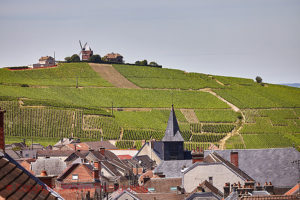 Champagne is the world’s most famous sparkling wine, even though Prosecco has overtaken champagne counted in volume. Champagne immediately brings to mind festivity and luxury, but today more and more people find that there is no need for a party to open a bottle of champagne. But maybe it becomes a party when the bottle is opened! During this autumn’s champagne tour it season will be either harvest time or immediately after which means that there is a lot of things happening and bustle inside the cellars and out in the vineyards. The presses go on churning day and night, the must bubbles, oak barrels and steel tanks are filled up. Join us on this wine tour to Champagne and experience all this and of course also you will enjoy some fantastic champagne lunches.
Champagne is the world’s most famous sparkling wine, even though Prosecco has overtaken champagne counted in volume. Champagne immediately brings to mind festivity and luxury, but today more and more people find that there is no need for a party to open a bottle of champagne. But maybe it becomes a party when the bottle is opened! During this autumn’s champagne tour it season will be either harvest time or immediately after which means that there is a lot of things happening and bustle inside the cellars and out in the vineyards. The presses go on churning day and night, the must bubbles, oak barrels and steel tanks are filled up. Join us on this wine tour to Champagne and experience all this and of course also you will enjoy some fantastic champagne lunches.
The gourmet city of Bordeaux, that also makes wine | wine tour
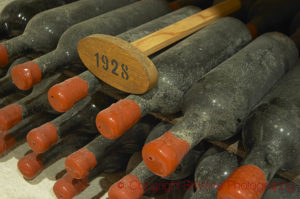 It is perhaps not surprising that Bordeaux is among France’s top destinations if you want to eat delicious food. Here you will find top- quality French gastronomy, at least on the lunches that we have on our wine tour to Bordeaux. They are often at one of the chateaux that we visit, yet they are on par with star restaurants. But that seems quite appropriate; here they also make some of the best wines in the world. It is full speed in the cellars and in the vineyards when the autumn wine tour takes place. They harvest merlot a few weeks before the cabernet, so the harvest time can be quite extended. Join us on this wine tour to Bordeaux and experience the outstanding food and wine this fall.
It is perhaps not surprising that Bordeaux is among France’s top destinations if you want to eat delicious food. Here you will find top- quality French gastronomy, at least on the lunches that we have on our wine tour to Bordeaux. They are often at one of the chateaux that we visit, yet they are on par with star restaurants. But that seems quite appropriate; here they also make some of the best wines in the world. It is full speed in the cellars and in the vineyards when the autumn wine tour takes place. They harvest merlot a few weeks before the cabernet, so the harvest time can be quite extended. Join us on this wine tour to Bordeaux and experience the outstanding food and wine this fall.
A choice of wine tours in South Africa
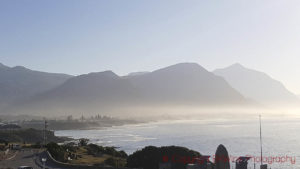 We have exceptionally two wine tours to South Africa on the program right now. Both contain lots of good food and good wines and other experiences. We showcase the best and most exciting South Africa wine districts on both programmes, including the trendy cool-climate district of Walker Bay with Hermanus and Hemel en Aarde. The first wine tour to South Africa will take place in November. At that time of the year it’s whale season. On that trip we have a half-day boat trip where we expect to get close to these amazing animals in the famous whale area near the city of Hermanus. The second wine tour to South Africa will be in February. Then it is not the whale season but instead it’s harvest time.
We have exceptionally two wine tours to South Africa on the program right now. Both contain lots of good food and good wines and other experiences. We showcase the best and most exciting South Africa wine districts on both programmes, including the trendy cool-climate district of Walker Bay with Hermanus and Hemel en Aarde. The first wine tour to South Africa will take place in November. At that time of the year it’s whale season. On that trip we have a half-day boat trip where we expect to get close to these amazing animals in the famous whale area near the city of Hermanus. The second wine tour to South Africa will be in February. Then it is not the whale season but instead it’s harvest time.
More long-distance wine travel: Chile-Argentina and New Zealand
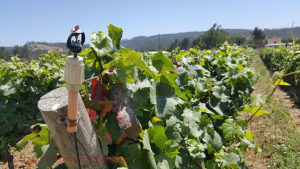 The year 2019 begins with our very popular wine tour to the two South American wine countries Argentina and Chile. Taking a close look at these two countries, you will find many small world-class wine producers. But the tour also includes a lot more, such as a breath-taking road-trip across the Andes.
The year 2019 begins with our very popular wine tour to the two South American wine countries Argentina and Chile. Taking a close look at these two countries, you will find many small world-class wine producers. But the tour also includes a lot more, such as a breath-taking road-trip across the Andes.
We have one more long distance tour to the wine country of New Zealand, which has had great success on the world wine market. The wine tour to New Zealand is a mixture of wine (not least sauvignon blanc but also much more) and nature and culture. We can promise a great experience.
Don’t be an egoist! Share with your friends and other wine enthusiasts! Forward the Brief to your friends! Suggest that they sign up for a free subscription !
© Copyright BKWine






